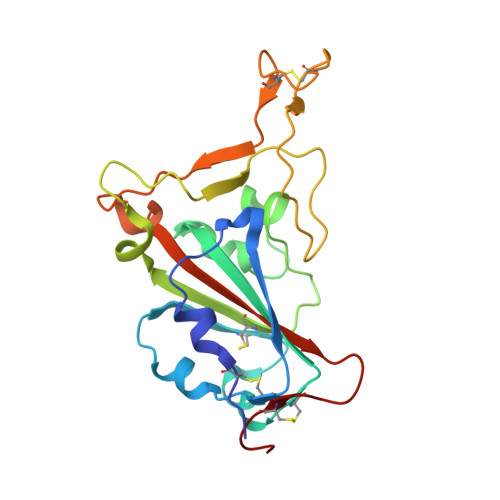Two pan-SARS-CoV-2 nanobodies and their multivalent derivatives effectively prevent Omicron infections in mice.
Liu, H., Wu, L., Liu, B., Xu, K., Lei, W., Deng, J., Rong, X., Du, P., Wang, L., Wang, D., Zhang, X., Su, C., Bi, Y., Chen, H., Liu, W.J., Qi, J., Cui, Q., Qi, S., Fan, R., Jiang, J., Wu, G., Gao, G.F., Wang, Q.(2023) Cell Rep Med 4: 100918-100918
- PubMed: 36702124
- DOI: https://doi.org/10.1016/j.xcrm.2023.100918
- Primary Citation of Related Structures:
7WD1, 7WD2 - PubMed Abstract:
With the widespread vaccinations against coronavirus disease 2019 (COVID-19), we are witnessing gradually waning neutralizing antibodies and increasing cases of breakthrough infections, necessitating the development of drugs aside from vaccines, particularly ones that can be administered outside of hospitals. Here, we present two cross-reactive nanobodies (R14 and S43) and their multivalent derivatives, including decameric ones (fused to the immunoglobulin M [IgM] Fc) that maintain potent neutralizing activity against severe acute respiratory syndrome coronavirus 2 (SARS-CoV-2) after aerosolization and display not only pan-SARS-CoV-2 but also varied pan-sarbecovirus activities. Through respiratory administration to mice, monovalent and decameric R14 significantly reduce the lung viral RNAs at low dose and display potent pre- and post-exposure protection. Furthermore, structural studies reveal the neutralizing mechanisms of R14 and S43 and the multiple inhibition effects that the multivalent derivatives exert. Our work demonstrates promising convenient drug candidates via respiratory administration against SARS-CoV-2 infection, which can contribute to containing the COVID-19 pandemic.
Organizational Affiliation:
CAS Key Laboratory of Pathogen Microbiology and Immunology, Institute of Microbiology, Chinese Academy of Sciences (CAS), Beijing, China.



















